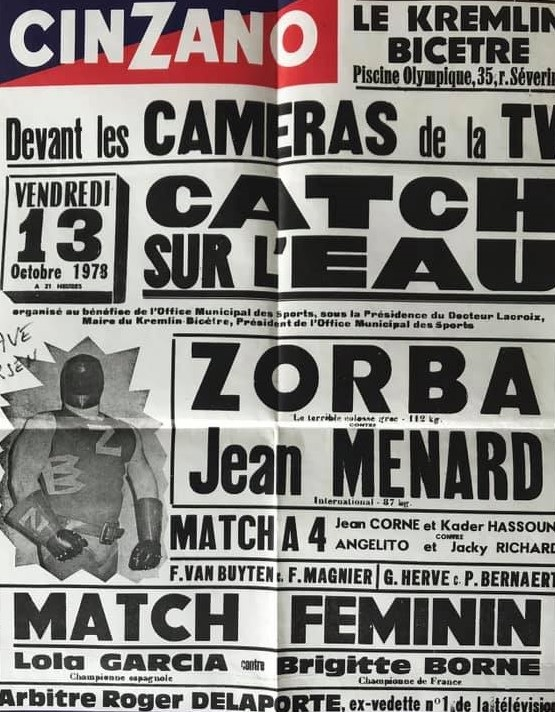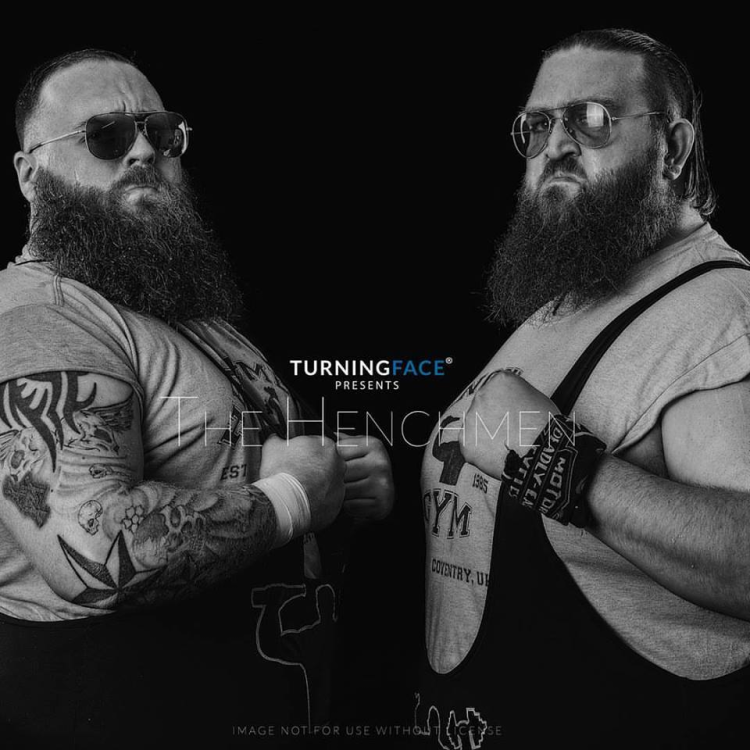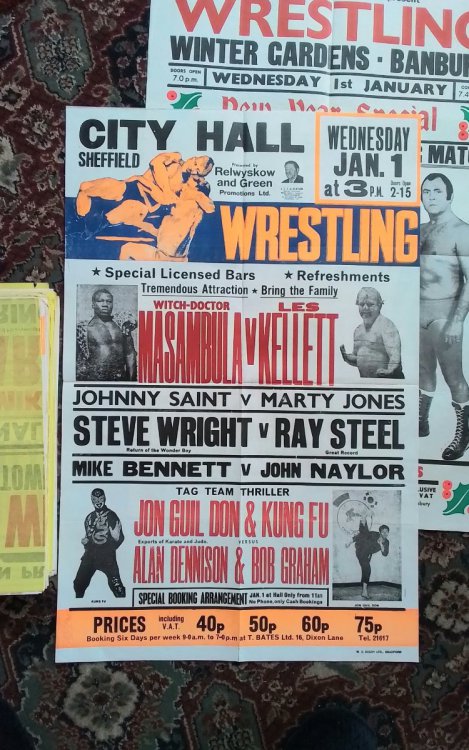
David Mantell
Members-
Posts
2111 -
Joined
-
Last visited
Content Type
Profiles
Forums
Blogs
Everything posted by David Mantell
-
The Beginner's Guide To British Wrestling
David Mantell replied to ohtani's jacket's topic in Megathread archive
Have copied and pasted the entire piece to the talk pages of the English Wikipedia articles for the CWA and VdB -
The Beginner's Guide To British Wrestling
David Mantell replied to ohtani's jacket's topic in Megathread archive
Bumping this review up and adding the 1972 bout video so we can see what their work together was like overall. As I have said, the short match is somewhat rushed and overstuffed for it's duration but the other three bouts show us two skilled wrestlers who expressed their sportsmanship and bonhomie through banter and humour but did Not veer into outright comedy matches, with the skill remaining the prime focus. You admire their work nut you also wouldn't mind joining these guys for a few rounds of cards or dominoes in the pub one night. -
The Beginner's Guide To British Wrestling
David Mantell replied to ohtani's jacket's topic in Megathread archive
Have found another couple of TV bouts they had besides the rather rushed above bout and the 1972 bout found on b/W film. Much more room for the bout to breathe in these than the short bout, you get a better feel for their technical abilities in these two and '72 also. -
The Beginner's Guide To British Wrestling
David Mantell replied to ohtani's jacket's topic in Megathread archive
He doesn't exactly make it easy does he? To be honest it's very hard to take apart the Wikipedia page for the CWA since all the sources called it that.(Verifiability Not Truth and all that.) It seems to me (and correct me if I'm wrong). that IBV is what people are referring to when they talk of the CWA- the promotion with the big ring with white ropes, blue or dark grey mat, covered in logos of sponsoring companies, gong instead of a bell. featuring Otto and a load of visiting Americans, filmed very professionally by a multi camera crew for home video. While the VBD are the Other lot, smaller ring, a lot like Britain, lots of Joint Promotions mid careers on the bill, also quite a few older Germans like Axel Dieter, filmed badly with a single handheld camcorder. -
Jim Cornette seemed impressed recently with the enthusiastic chanting French audiences at Backlash France. I sent him a potted history of French fan chants. We'll see if he and Brian read it out.
-
The Beginner's Guide To British Wrestling
David Mantell replied to ohtani's jacket's topic in Megathread archive
Interesting. The ring looks like French Wrestling especially the red roped one in the first clip. Beau Jack Rowlands wasa journeyman blue eye heavyweight on 70s WOS, I thing he faced Daddy solo in 1976, probably with Daddy still the heel but don't quote me on that. The gong for a bell and the referee with a football whistle were very much regular tropes of the CWA era (apparently the promotion everyone calls the CWA was called the IBV back then - is that correct serg1e? Roland Bock reminds me of the younger Rex Strong before he got ill and piled on the pounds. -
The finish of this, with Villars counted out to 10 on the mat, is one of those Knockout finishes I was telling yo all about in the '"Why is America assumed to be the centre of the wrestling universe?" thread.
-
The one where Angelito got so fed up of Richard he sel-unmasked mid match. They were still going at it nearly two decades later:
-
The Beginner's Guide To British Wrestling
David Mantell replied to ohtani's jacket's topic in Megathread archive
There has recently been a revival of the "Sword of Excellence" angle from 2008 between Bagga and the then aging (66) and now outright elderly (82) Kendo Nagasaki, with Bagga having bragged about being able to take on Kendo himself to keep the sword in LDN custody. Curiously at this point Bagga seems to be the heel and Nagasaki seems to be the blue-eye in all this. There was meant to be a confrontation between the two at Fairfield Halls Croydon recently (in one of the smaller rooms, not the legendary Concert Hall that was All Star's equivalent of MSG 1985-2013 - I suppose the equivalent would be the Felt Forum). Naggers showed up, doing his own speaking for once (in Thornley's native Staffordshire accent) and collected the sword to cheers from the Croydon crowd which must surely have included surviviors of the original South London Hellcrew which staged RIOTS at this venue when he appeared there or at nearby Lewisham Theatre Catford 31-37 years ago: Ring announcer is our old friend Leigh Bamber -
-
Before there was Kim Chee there was Madame M'boba
-
The Beginner's Guide To British Wrestling
David Mantell replied to ohtani's jacket's topic in Megathread archive
16 years ago at the Sunderland Empire. Two of the best of the Noughties. -
The Beginner's Guide To British Wrestling
David Mantell replied to ohtani's jacket's topic in Megathread archive
Nice 1-1 draw from Leeds 1986, good folding press from Martin for the opening fall, ather like his No Contest with Marty Jones at the RAH in 1980 -
The Beginner's Guide To British Wrestling
David Mantell replied to ohtani's jacket's topic in Megathread archive
As I mentioned before, the Henchmen are to my mind the modern equivalent of the Klondykes in 1971. In between times there were various tag partnership Giant Haystacks had with pre-peoples' hero Big Daddy, King Kong Kirk, Bully Boy Muir but probably the most apt partner for this lineage, Scrubber Daly. After that, there were the UK Pitbulls in the Noughties. They mostly worked New School promotions but occasionally turned up for All Star - and indeed there is some Premier footage in this docu about them: (WARNING there is also some pretty godawful footage of Hardcore/Death Match promotions in this docu towards the end.) -
The Beginner's Guide To British Wrestling
David Mantell replied to ohtani's jacket's topic in Megathread archive
Doucumentary from 1971 about The Klondyke brothers, a superheavyweight tag team in the days before Big Daddy became the scourge of all monster heels (after having been one himself for a bit!). https://www.facebook.com/watch/?v=384318719496070 Notice the big celebration over the Klondykes getting disqualified - and consider what I said about DQ finishes and how it can be anything but a cheap finish to see the heels get sent packing in disgrace if done correctly. Footage from this was later used in this episode of legendary BBC sitcom Til Death Us Do Part rather than pay ITV for footage of actual TV wrestling broadcasts: THe Klondykes were never a tag team on proper Wrestling TV anywhere but Jake got one World of Sport match in in 1976, while Bill as I think we've mentioned on the French Catch thread, got one French TV bout in the early 70s: -
The Beginner's Guide To British Wrestling
David Mantell replied to ohtani's jacket's topic in Megathread archive
Probably THE biggest feud in All Star in the early 21st century was Dean Allmark versus Robbie Dynamite (Berzins). Often for the British Mid Heavyweight championship (formerly held by the late great Mike Marino and vacant from his death in 1981 until Dynamite filled the vacancy in 2002), on this occasion "Deano" comes in as British Heavyweight Champion. https://www.youtube.com/watch?v=_cCxV3MwGhc (embed not working) -
Bob Plantin has started up a Facebook group https://www.facebook.com/groups/1188513425037928 Unfortunately he doesn't seem to want other people posting stuff on there and refuses to accept that French wrestling carried on after 1985 (although the group is titled CATCHEURS FRANCAIS 1950 / 1995)
-
The Beginner's Guide To British Wrestling
David Mantell replied to ohtani's jacket's topic in Megathread archive
That sounds encouraging, maybe someday we will have George Kidd in his prime and the first two generations of Wigan Snakepit wrestlers to watch. -
The Beginner's Guide To British Wrestling
David Mantell replied to ohtani's jacket's topic in Megathread archive
I haven't paid much attention to the Knight Family's WAW, mainly because in their early days in 1994 they aspired to be an "American style" promotion, but as more and more old school talent worked for them, they became more of a Traditional British promotion. This bout is from Great Yarmouth 2005 and features not only a match under full Mountevans rules but also the unusual sight of Ricky Knight, the bigger and heavier of the Superflies tag team. wrestling cleanly and behaving in a sportsmanly fashion. Granted he is more of a strength wrestler up against skilled technician Quintan, but he keeps it mostly clean and here is even a bit of the banter that Faulkner and McMichael would use to spice up their (primarily scientific) bouts. -
Haha you could get a few important older people in British wrestling upset by slagging off dear old Orig! But anyway, that's the first place I ever heard the name Charlie Verhulst (pronounced Veruce) mentioned.
-
Try telling that to the late Orig Williams,See his comment at 1:22 of this:
-
-
Wel I got it anyway! It was just a bog standard five rounds no score draw! The "purse"you mention was the Prime some stinkin' rich fan offered to pay each man for a good scientific bout this far. At the end of the fight MC Raymond Poignard (sp?) pauses to check with the ref before confirming it is indeed a draw.
-
As with All Star, Rumble and the late TWA in C21st UK the rounds here were basically a relic rather than a novelty. I'm not bothered who "owns" the moves as long as it makes for a good skillful bout. At least Guy Mercier isn't slapping the referee around (as he would start with poor old Michel Saulnier about 7 years later.)
-
Am watching this bout. So they did have rounds in France after all. At least sometimes. Verhurst (pronounced Veruce) was cited many years later as Mile Zrno's trainer by Orig Williams on English language commentary during a CWA Zrno Vs Fit Finlay match screened as part of a New Catch episode on Eurosport. Interesting looking venue with the big coach-and-horses doors and lamp pillars. Hopefully there are retrievable chroma dots on this film as I would love to someday see what this place looked like in colour. Nice bit with the two heels at the start. Kurt Kaiser must have been very close to the bone for a country under Nazi occupation just over 25 years earlier. Latasserre (sp?) being a great arrogant heel. They're doing "primes" again! Both men get awarded a hefty prime of 10,000F during the head scissors escape sequence (with Mercier forming a human corkscrew with his bent legs to help twist out of the hold.) The curse of the celeb intellectual colour commentator strikes again, this one wants LeFoudre to win because he looks the more sympa of the two.


